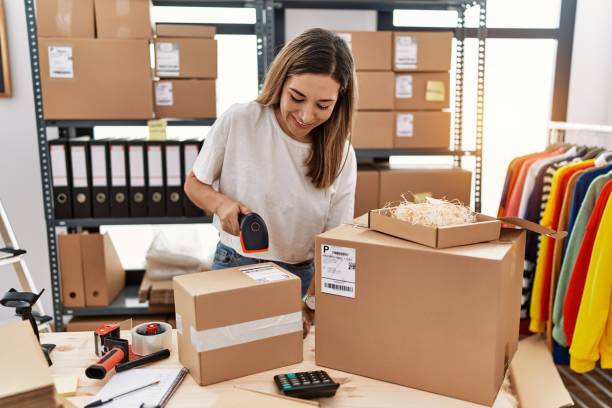Online returns continue to be a major point of frustration for many online businesses that tend not to plan for it. Returns logistics, or reverse logistics, is a sophisticated process in itself that should be thoroughly explained and understood. How you go about managing the returns process directly affects your profit and loss as well as your customer loyalty.
First of all, returns should try to be avoided at all costs obviously, because it takes up time and money, right? This means making sure you deliver on what you promised and that you had good photos and descriptions of your products. Many returns happen simply because what was delivered wasn’t promised or presented in a clear manner. However, if returns do happen, you need to have a strategic process in place that ensures your customers remain happy, and you can restock and resell your products. On top of that, plans need to be worked out on what to do with excess stock that can’t be resold.
A recent report from IMRG revealed that online returns were on a meteoric rise in 2021. This reflects the obvious uptick of eCommerce sales worldwide due to Covid – meaning the more deliveries you have, the more returns you will have too. Returns are typically viewed as bad by most eCommerce sellers. However, the truth is that how you choose to handle this process could be beneficial to your business. It’s actually an opportunity to prove yourself. Handling online returns is an opportunity to show precisely how your business delivers on your customer service standards, no matter the issue.
Research reveals that 92% of customers will purchase again from a retailer if the returns process was easy. This statistic matters. Don’t just assume you will lose customers if they ask for returns on your products. Therefore, let’s discuss returns logistics and efficient processes for returns management.
WHAT IS REVERSE LOGISTICS?
Unlike regular logistics, which is all about delivering packages to your customers, reverse logistics (also known as returns logistics) is the opposite – moving the goods from the customers back to the warehouse or seller. This returns management process may be triggered for many reasons.
Table of Contents
Toggle- If the product was defective and needs to be returned
- If the product was the wrong colour, shape, or size
- If the customer was just generally unhappy in some other way with the product
Unfortunately, in eCommerce, online returns are inevitable. The challenge for many logistics providers and sellers is creating a returns process that is efficient, cost-effective, and convenient.
WHAT IS RETURNS MANAGEMENT?
Returns management is the process and systemic approach of first determining how a return will be processed, then the execution of it. This will differ depending on who will receive the goods, what the return policy is, and what the customer preference is (if given multiple options). When the returns process is effectively managed intelligently and efficiently, it means a better customer experience, increased retention, and profits.
HOW REVERSE LOGISTICS WORKS
The reverse logistics process starts with the customer initiating their eCommerce returns or single return, and by the end, the goods will be received and processed by the seller, manufacturer, or 3pl.

Young hispanic woman smiling confident working at store
1. THE CUSTOMER STARTS THE RETURNS PROCESS
Returns management starts with the customer determining why they want to return a product. They need to check the returns policy first to determine if they can return items. Some items may not be able to be returned and it always depends on the seller or returns contract. Once this is determined they will begin the returns either by mailing it, dropping it off in person (if possible), or arranging pickup (if offered). Mailing obviously costs money, and the customer may or may not get a refund (depending on the seller). Dropping off in person is obviously free (if possible), and new methods of arranging pickup may or may not require a small fee.
2. THE RETURN IS RECEIVED
The warehouse returns process is started either at the manufacturer warehouse, a physical stores warehouse, or a 3pl warehouse. For eCommerce businesses that use Shopify or WooCommerce and use 3pl services, the 3pl accepts the returns on behalf of their client’s customers. This then begins the quality check process for the return.
3. THE RETURN IS CHECKED
Warehouse returns procedures dictate that all items have to go through a quality check process to determine if the items can be resold. Products will be inspected for any type of damage, deterioration, or deformity. If there are no issues that have been found, online returns are sub sorted into items, based on their stock-keeping unit number, and will be readmitted into the stock for the specific vendor area. If items are damaged, however, they will not be returned to the regular stock area. They will either be trashed or repurposed. Some companies choose to donate some items to charity should they no longer be fit for customer use. This is a great way to reduce waste and positively impact communities.
“PRODUCTS USE PRECIOUS RESOURCES WHICH ARE BECOMING SCARCE AND WE ARE THROWING THEM AWAY UNNECESSARILY.”
-Sarah Needham, Centre for Sustainable Fashion
4. THE RETURN IS PROCESSED
Finally, using returns management software, the item can be added back to the original stock – assuming there are no issues obviously. The item is given a new SKU number and a refund can be triggered at this point.
BENEFITS OF REVERSE LOGISTICS
There are many benefits to an efficient returns logistics process. Proper supply chain management includes maintaining profit, reducing environmental impacts, and maintaining brand value. Recouping value is still possible through reverse logistics.
CUSTOMER SATISFACTION
Good returns logistics build trust with your customers. If a returns experience is managed well, they will shop with you again. You always have a chance to wow customers. That starts from the website to final mile delivery and returns.


REDUCES MONETARY LOSS
Items returned in good condition can be resold – resulting in no monetary loss. The cost of providing refunds for mail delivery returns for customers can be a factor – however, it is minimal and still mitigates losses. Manage this with more clear return policies.
ENVIRONMENTAL IMPACT
We all have a responsibility to encourage sustainable practices in relation to waste. Instead of simply trashing items, more can be reused and repurposed. It is estimated that 5 billion pounds of waste are generated through returns each year.
EFFICIENT REVERSE LOGISTICS MANAGEMENT
Effective returns management for eCommerce is still a relatively new concept that begs for innovation. Clear policies and automation are great – but is enough being done? Companies don’t necessarily have a binary approach when it comes to online sales – only focusing on the first part of the journey.
The question companies need to focus on is “If online commerce makes it more convenient to shop from home and receive packages from home, why can’t the opposite be true?” This means if I can receive packages at home – why not send them back from home? This is the future of eCommerce returns.
62% OF CUSTOMERS WOULD CHOOSE COURIER COLLECTION AS THEIR CHOICE OF RETURN SERVICE.
RETURN ROBIN
Selazars partner company Return Robin was designed for this purpose. Customers can manage and monitor multiple returns from home, saving them trips to the store or packaging returns for Royal Mail delivery. They innovate in the following ways.
- Returns can be submitted online: Customers can enter their return details and choose a date that suits them for return pickup from a courier, between Monday-Saturday – up to two weeks in advance.
- Customers get notified of a 2-hour collection window on their chosen date.
- A courier drives to the customer’s home to collect the parcel. No packaging label is needed as the courier prints and provides it.
- The parcel reaches its warehouse, and the return can be refunded within days. It can often take 30 days or more to receive refunds today after you mail it – so this is huge. Incentivise your customers more and they will repay you with more loyalty.
This is the type of innovation and convenience your customers need. Through awesome products, customer support, and great returns, you will create raving fans.
THE IMPORTANCE OF REVERSE LOGISTICS
Returned items need to be a larger focus for eCommerce sellers because it is an opportunity to not leave money on the table while pleasing your customers. Online returns can’t be viewed as an ad hoc measure – and need obsessive focus on the reverse side of the customer journey too. Refunds are inevitable, so offering great return policies and methods for customers earns trust and builds return business. If you want to learn more about reverse logistics for your business, schedule a free no-obligation discovery call today.
